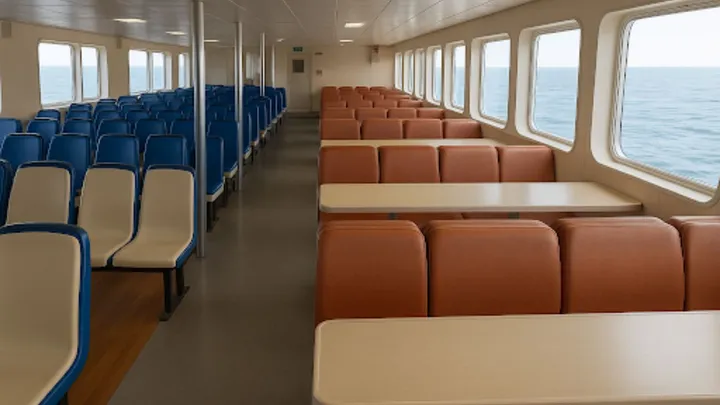

How the Companies and Vessel Types Differ on the Ferry from Salerno to the Amalfi Coast
You've probably heard that taking a ferry from Salerno to the Amalfi Coast beats sitting in bumper-to-bumper traffic along those winding coastal roads. But here's what most travel guides won't tell you: not all ferries are created equally.
The company you choose and the vessel you board can completely transform your journey from a simple transportation leg into either a memorable coastal experience or a cramped, uncomfortable ride.
The maritime route between Salerno and the Amalfi Coast operates under a network of companies, each deploying different vessel types with distinct characteristics.
Understanding these differences matters more than you might think, especially during peak summer months when boats fill up fast and schedules shift without warning.
The Main Ferry Companies and Their Characteristics
Several trusted companies operate the routes between Salerno and the coastal towns, each with its own schedule, pricing, and style of service. The primary operators you will encounter are Travelmar, NLG (Navigazione Libera del Golfo), Alicost, Positano Jet, and Grassi Junior.
To quickly compare your options, the table below outlines the key operators and their general characteristics:
Travelmar is known for its frequent and reliable service, making it a favorite among travelers heading to the Amalfi Coast. A one-way ticket to Amalfi typically costs around €12. The luggage policy allows one free piece of baggage up to 45x35x20 cm.
NLG (Navigazione Libera del Golfo) offers direct connections from Salerno to Amalfi, making the trip quick and convenient. The fare is usually around €15, and passengers can bring one piece of luggage measuring 50x30x15 cm and weighing up to 5 kg free of charge.
Alicost is known as a budget-friendly option for travelers. Fares can start as low as €6.50 to Amalfi. The luggage allowance includes one piece with a maximum size of 50x35x20 cm and a weight limit of 9 kg.
Positano Jet focuses on speed and efficiency, offering faster travel times compared to other ferry companies. A ticket typically costs around €14.50. Only a small personal bag is included for free, with extra charges for larger bags.
Grassi Junior stands out for its scenic routes that include multiple coastal stops along the way. Ticket prices range from €9 to €11.50, and there’s a €2 fee for carrying luggage.
These companies provide a range of choices. Travelmar is often noted for its frequency and is a cornerstone of coastal transport, while operators like Alicost can offer more budget-friendly tickets. NLG and Positano Jet are known for their faster journeys, which is a significant advantage if your time is limited.
Understanding Vessel Types and Journey Times
The two main types of vessels you will find on this route are high-speed ferries (often hydrofoils) and conventional ferries. Your choice between them will directly impact your travel time and the nature of your scenic ride.
High-speed ferries are the most common option for this route. They are designed for efficiency, cutting the travel time from Salerno to Amalfi to just 25 to 35 minutes for a direct crossing. While these vessels are faster, they’re also more expensive than traditional ferries, which offer a slower but more affordable way to travel.
Conventional ferries typically offer a more leisurely pace. Some services, like those offered by Grassi Junior, take a longer and more scenic route that includes stops in charming towns like Cetara, Maiori, and Minori.
This can turn your transfer into a mini-cruise, lasting about 1 hour and 15 minutes and allowing you to see more of the coastline from the water. It is a wonderful way to begin your Amalfi Coast adventure if you are not pressed for time.
Capacity and Comfort Differences
Vessel capacity varies dramatically across the ferry fleet. Smaller hydrofoils might carry only 100 passengers, while the largest traditional ferries accommodate over 400. This difference impacts your experience in several ways.
Smaller vessels mean more intimate journeys. You're more likely to find good spots and move around freely. The boarding and disembarking process happens faster with fewer people to manage.
Larger ferries offer more amenity options. You'll typically find better bathroom facilities, small cafeterias or snack bars, and dedicated luggage storage areas. Some larger vessels include small shops selling drinks, snacks, and tourist items.
Seating configurations differ substantially. Budget-oriented operators might install plastic bench seating throughout. Premium services offer cushioned seats with tables. Some vessels include a mix of seating types, with basic benches in some areas and more comfortable options in designated sections that might cost extra.
Speed and Schedule Implications
The vessel type directly determines travel time. This matters more than travelers often realize when planning their coastal itinerary.
Hydrofoils complete the Salerno to Positano run in roughly 40 minutes. Traditional ferries need 60 to 75 minutes for the same journey. That 30-minute difference might seem minor, but it compounds when you're making multiple stops or have afternoon plans.
However, faster isn't always better. The extra time on a traditional ferry lets you properly appreciate the coastal scenery. The cliffs, villages, and coves of the Amalfi Coast deserve more than a hurried glance through a hydrofoil window.
Schedule frequency varies by company and season. Some operators run hourly departures in summer, while others might offer only three or four daily options. Companies operating faster vessels often maintain tighter schedules with less buffer time between trips.
Weather-related cancellations present another scheduling consideration. Hydrofoils cancel service more readily than traditional ferries. If your travel plans can't accommodate flexibility, booking with an operator using sturdier vessels reduces cancellation risk.
Want the ultimate slow-coast experience? Book our Vintage Fiat 500 Tour and drive along the same cliffs in an iconic open-top classic.
Practical Considerations for Choosing
Your choice of ferry company and vessel type should align with your specific travel priorities.
Time-constrained travelers benefit from hydrofoil services despite the reduced scenic experience. Business travelers and day-trippers often prefer this option. The enclosed cabins also appeal to passengers concerned about sun exposure or sea spray affecting their clothing or electronics.
Photography enthusiasts and first-time visitors should prioritize traditional ferries with good deck access. The slower pace and outdoor viewing opportunities produce better images and memories. The longer journey time becomes an advantage rather than a drawback.
Senior travelers and those with mobility concerns should verify the vessel's boarding arrangements. Some smaller boats require navigating steep or narrow gangways. Larger ferries typically offer easier access with wider, more stable boarding platforms.
Budget-conscious backpackers naturally gravitate toward the cheapest options. Just remember that saving five euros doesn't provide much value if the journey becomes uncomfortable or you miss connections due to cancellations.
Find Your Perfect Ferry Match
Understanding these differences is the first step, but you do not have to navigate all those options alone. We help simplify your choices by matching you with the ideal operator and vessel for your travel style and budget.
Why spend hours comparing schedules and policies when our resources can point you toward the best ferry from Salerno to the Amalfi Coast for you? Let Exploring Amalfi Cost help you start your coastal adventure with confidence.